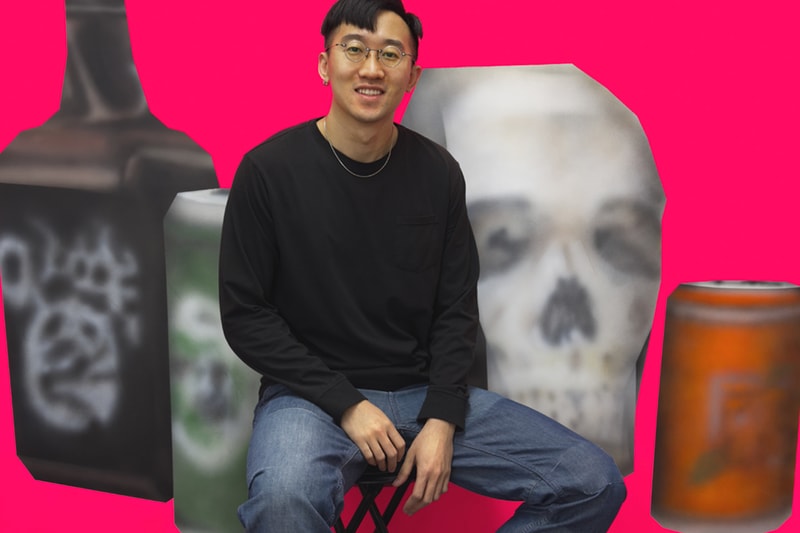![]()
Ah, simulation theory, the idea that we’re living in a supercomputer controlled by a higher intelligence. It’s the kind of jargon you’d likely hear at the afters, cornered into a conversation with a stranger that you can’t seem to get out of or with that one uncle at a family gathering that your parents told you to be wary of. While shrugged off by religious and non-religious folk alike, simulation theory is also equally as un-dismissable as any creation story out there — adding to its intrigue.
“I believe it,” laughs Gao Hang, the Chinese-born, Houston-based artist known for creating graphically-charged compositions that look like cropped-in Nintendo 64 graphics merged with a hard-edge abstract painting from the likes of John McLaughlin or the late Frank Stella. “It’s the other us,” Hang tells Hypeart over Zoom — the technology in which we communicate, also adding another meta layer to the conversation. “Once we invent independent thoughts by using AI, it essentially means we’ve invented another civilization, because they are existing on their own — which I believe proves we are a simulation as well. There is no way we are the first ones in the chain,” he added.
Observing Hang’s work is akin to zooming into the far corners of a late 90s to early 2000s video game, where the graphics — revolutionary for its time, as it was the first instance in which consoles had entered three dimensions — give way to hilarious and downright terrible renderings of what the real world actually looks like. The artist refers to them as “digital cave paintings” — artifacts of the past 30 years which will be studied by future civilizations who look to piece together a story of our given period (or simulation.)
Born and raised in Baoding, roughly three hours southwest of Beijing, Hang immigrated to Houston to continue his MFA program in art when he was 25. Seven years later and the fledgling artist has become a notable figure within the contemporary scene who is blending fine art with images once confined to the realm of video games. Think of one of Donald Judd’s inquisitive stack sculptures, but instead of uniform blocks descending down the wall, they’re glitchy stacks of cash. His work is tongue and cheek, but veers away from being overly slapstick. Hang describes his practice as a “documentation” of his “thoughts on social media and the internet. But not just Facebook and Instagram but online gaming as well and how people behave digitally.”
To learn more, Hypeart went down the rabbit hole with the Houston-based artist to discuss his practice and whether a higher intelligence is controlling us as we speak.

"Art is all about studying yourself."
What are your memories of art, the inspirations that have shown to have an impact on you years later?
I started drawing and painting as a kid in China, up until about age 25. Then I moved to Houston for my master’s degree. My mom taught physics and my dad worked in an administration job. They would take me to nearby villages where I’d paint old historical houses, mountains and trees.
That’s what got me started, without any knowledge and skillset, beforehand. But that’s what taught me the true feeling of what drawing and painting can make one feel.
You’re constantly mining for references to recreate from art history. Are there particular periods that have influenced you more? But also, having grown up in China, Eastern art history is a whole other canon as well. Can you talk about some of the differences and similarities?
Eastern [art] is more about being a whole or elegant person. Back in the Qin Dynasty, artists were a combination of painter, poet and just a good person. [laughs]. They are the ideal person, never do anything bad and just strive to be as pure as possible. That’s the main influence of so-called Chinese traditional art — from landscape paintings to drawings, which represent a kind of elegancy and an ambition supporting the country and people. American art is always changing with religion, economy, social issues and war, as well as advertisements. I would say that Western art has shown to grow with social and economic changes, while Chinese is more stable — about inner good and how to be a better person.
When you make your own art, do you constantly see yourself critiquing the perceptions of both West and East in your work?
When I was in China, I was still an undergrad and not that mature in mind. I've developed and started a new life here. So Western art has shown me how to behave. I never really compare the two. In terms of how I use those two histories: I think Western art history inspired me little bit more. Every month, I’ll go to a museum, like the Menil Collection — which is one of the biggest in America — and check out their installations from the Renaissance all the way to the 20th century.
You go through all these works by timeline and suddenly you stop and have this momentum to keep going. So I try to feel and analyze that momentum in what’s going to happen next. That blank space is what I’m trying to, and all artists are trying to figure out.
How was your transition from China to the US?
I was living with my parents in China, so mentally, physically and financially, I never really had that independence. Once I landed in Houston, I was on my own — every decision and how to make money.
I would also say that Western art professors are more open-minded and loose, in terms of them not telling you exactly what to do, instead guiding you and just providing materials and information. In China, they really just instruct you what to do, which can be very specific. Art is all about studying yourself. As we grow, your art will become more mature and powerful.
When I view your work, I instantly think of Goldeneye and other PS1-N64 video games — where at the time, the graphics felt like such an upgrade from where things were at with the consoles prior. But in hindsight, they look like primitive etchings but just in a digitized form. How did your video game aesthetic develop?
My last solo in Bangkok was at the Tang Contemporary and the title was called Digital Primitivism. In the late ‘90s and early naughties is when the first three-dimensional games came out, which in hindsight, look like cave paintings. But you can still recognize what it is. It works well, despite being raw. That shock, to me, is one of the main impulses that I make my work. In our formative years, all of a sudden you have this 3D video game like Counter-Strike (1999), and everything looks so real. You have physical roles, moral roles, physical gravity and you can walk through space and time — all you need for another world. That shocked me.
A lot of my work features zoomed-in crops of characters, where they may appear dumb looking, because that’s what I always did while playing Counter-Strike. When you die, you get to float around like a ghost. So I always went around the map to see objects really close, where I think now, it’s because I wanted to spot out the flaws just to know that it’s not a real world, just one created by humans. The pixelated rawness and blurriness gives you a comfort.
"Peoples’ behavior online will eventually invade our real life."
How would you define your practice and are there any overarching themes and message you look to address?
It’s really a documentation of my thoughts on social media and the internet. But not just Facebook and Instagram, but online gaming as well and people on the internet and how they’re behaving.
How do I feel about social media? It’s exciting, scary and odd. Peoples’ behavior online will eventually invade our real life. The first impression I had of this was back in 2015 or ’16: I suddenly realized you see all these influencers and they’re a different species. The way they talk, behave, interact, language, value system, everything. It’s not human, to me, anymore. I almost think they’re like lizard people.
I started to think about how I organize my work to comment on them. So a lot of my characters are like influencers — not me telling people they are — but that’s the abstract feeling that I get being surrounded by them and social media.
When we’re in a certain period, it seems like it will last forever, like MySpace or Facebook, but it never does. What does the post-social media world look like to you?
Platforms can come and go, but those people are the same people. It’s just a different platform, so it will keep going until there is the full metaverse. This parallel universe. Again, excited and also scared.
Can you walk us through how you approach a work from first thought to final execution?
I like to watch game walkthroughs, because I suck at playing games. I’ll watch a lot of interesting graphics from around the 2000s era. I’ll take my game emulator, download the game and do a bunch of screenshots, then use Photoshop to reshape things.
Alex Katz is one of my biggest inspirations, because his characters look like everyone — but at the same time, they don’t as well. I’m trying to instill the same idea when I paint 2000s-era video game characters. Another art period that I draw from is hard-edge painting or color field painting. I don’t want my pantings to have a narrative, which explains why I zoom in a lot on the characters’ face, where the figure itself becomes a field of color, which I’ll complement by another solid background color through the lines and how they divide.
All of this happens in Photoshop and when I pre-process the screen shots. After that, I’ll draw the compositions on the canvas and abandon my digital image and use my memory to transcribe the picture on the canvas. That’s the painterly aspect of it to me. Each piece takes about three days of painting, but I’m in the studio every day.
Before I finish, a personal strategy for me is to imagine my painting next to its inspiration, like Katz or Andy Warhol, in an art museum and ask myself: ’Is this embarrassing?’ If it’s not, quality wise, that’s ok. If it is, I’ll keep working on the piece.
"There is no way we are the first ones in the chain of inventing another civilization."
Humor is a big component to your art, but not so much slapstick. Is that something you consciously think about while making your work?
There is a lot of discussion about titling artworks and what function a title should serve. To me, words are words. I love standup comedy and one liners. They’re two-to-three sentences, where the first few describe the scene and the last is the punch line. You know something is going to happen when the truths posited in the first few lines are set. So I think the titles of my work are more like the first sentence in a one liner.
This may be a controversial opinion, but I think we are too sensitive right now. Partially because of social media. We have a lack of humor and I think my work is in protest of that by providing those right-on-the-boundary statements. You may be offended on first glance, but can see the humor in it as you sit with the piece — that uncomfortable boundary.
How about this latest body of work at Pulpo Gallery?
It doesn’t really have a theme. Instead it’s organized by a selection of work that I thought would go together. I really don’t set a theme for my work and the titles are also simulated. That’s another big debate: the people who think we’re in a simulation versus those who believe in biological evolution. I sort of believe we are in a simulation.
What do you think lies outside the boundaries of the simulation? Do you think there are aliens controlling us?
It’s the other us. A higher intelligence. Just like AI: once we invent independent thoughts by using AI, it essentially means we’ve invented another civilization, because they are existing on their own — which I believe proves we are a simulation as well. There is no way we are the first ones in the chain of inventing another civilization. I know it totally sounds like a conspiracy theory.
Once you have independent robots, you can’t let them know that we existed, otherwise they won’t enjoy their universe. You leave them in their environment and never let them find out they were created by another.
All art courtesy of Gao Hang.
Read more at Hypebeast











































